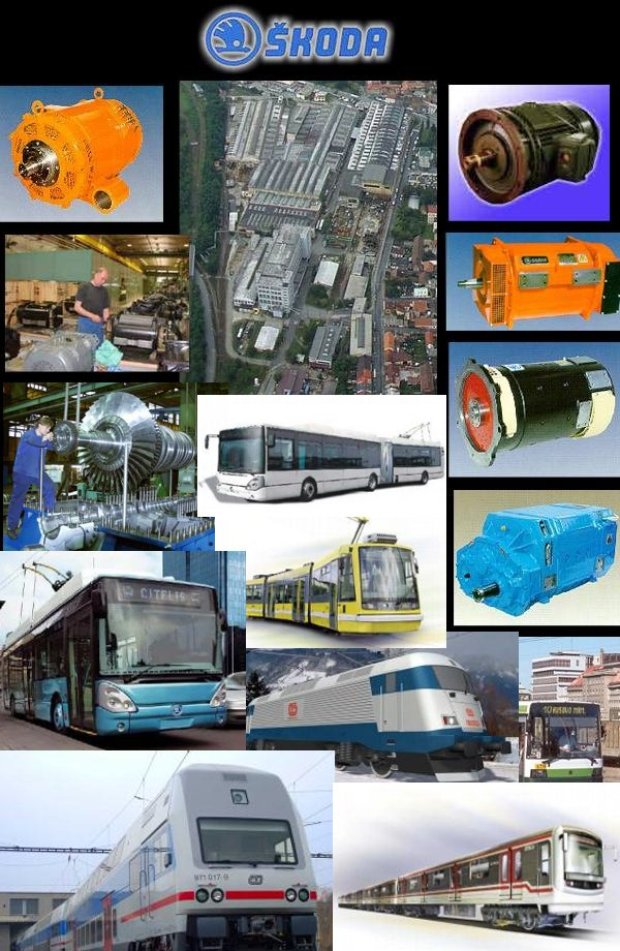SKODA HOLDING factories in the town PlzenSKODA MUSEUM & SKODA POWER & SKODA TRANSPORTATIONOrder Tour Code: C SWW8 | |
Tour availability:


|
Company History
In 1859, Count Wallenstein-Vartenberk set up a branch of his foundry and engineering works in Plzeň. The output of the plant, employing over a hundred workers, included machinery and equipment for sugar mills, breweries, mines, steam engines, boilers, iron bridge structures, and railway facilities. In 1869, the plant was taken over by Emil Škoda, an industrious engineer and dynamic entrepreneur.
Skoda was quick to expand business, and in the 1880s founded what was then a very modern steelworks capable of delivering castings weighing dozens of tons. Steel castings and, later, forgings for larger passenger liners and warships went on to rank alongside the sugar mills as the top export branches of Skoda's factory.
In 1899, the ever expanding business was transformed into a joint-stock company, and before the First World War Skoda Works became the largest arms manufacturer in Austria-Hungary. It was a navy and army contractor, mainly supplying heavy guns and ammunition.
Exports included castings, such as part of the piping for the Niagara Falls Power Plant or for the Suez Canal sluices, as well as machinery for sugar mills in Turkey, breweries throughout Europe, and guns for the Far East and South America.
The First World War brought a drop in the output of peacetime products. Huge sums were invested into expanding production capacities. By this time, Škoda Works already held a majorities in a number of companies in the Czech Lands and abroad that were not involved in arms manufacture. In 1917, the company had 35,000 employees in Plzeň alone.
Following the emergence of the Czecho-Slovak Republic in 1918, in the complex economic conditions of post-war Europe the company was transformed from what was exclusively an arms manufacturer into a multi-sector concern. In addition to traditional branches, the production programme embraced a number of new concepts, such as steam (and later electric) locomotives, freight and passenger vehicles, aircraft, ships, machine tools, steam turbines, power-engineering equipment, etc.
In 1923, the company's world-famous registered trademark - the winged arrow in a circle - was entered in the Companies Register. The deteriorating political situation in Europe saw arms production rise again in the mid-thirties.
The Second World War and the company's forced integration into the German weapons programme led to serious damage at the Works themselves (70% of the company complex was destroyed by Allied bombing in April 1945) and the loss of several foreign markets.
In 1945, the company was nationalized. Skoda Works was gradually split up into different sections (e.g. the car works in Mladá Boleslav, the aircraft plant in Prague, factories in Slovakia, and other plants producing food-industry equipment). The company's main task now was to produce equipment for heavy engineering, capital construction in the industrial sector, public transportation, and power engineering. Most exports were headed towards the Eastern Bloc.
Following the change in political climate in 1989, SKODA started along the path of privatization, and used this time to come up with an optimal production programme, make new business contacts, and look for markets other than those that had so far been its priority (and only) markets, i.e. the Comecon countries and the Soviet Union, which collapsed after 1989.
In 1992, the company was privatized by the so-called Czech method. It began expanding its production activities (e.g. by acquiring the TATRA and LIAZ vehicle works and constructing a plant to produce aluminium drinks cans). This expansion put the company's financial stability in jeopardy. In 1999, it concluded a standstill agreement with its main creditor banks, and restructuring of the entire capital structure of the Škoda group was launched. The result was legal and financial stability at the company. Now the sectoral restructuring of the production companies in the group is under way. In April 2000, SKODA HOLDING a.s. took over at the helm, controlling
primary nineteen subsidiaries and most product lines
|
The price list of Private Country Trips.
|

Together with its subsidiaries, Skoda Holding a.s. has a headcount of 4,300
employees (in connection with the sale of a new number of branches to new
owners – c.f. the Appian Group and SKODA HOLDING introduce their development
strategy – more than 4,000 erstwhile employees of Škoda Holding have
transferred to new owners since 2000; conversely, new acquisitions – VUKV,
Sibelelektroprivod, and CKD Vagonka – have brought in 1400 more people).
The company SKODA POWER is one of the most
important European producers and suppliers of the technological equipment
and customer services in the power industry with more than a century-old
tradition of steam turbine production in Skoda design .
Products of SKODA POWER a.s.:
Machine halls
Steam turbines
Heat exchangers and condensers
Service and modernization
Module Turbine Design SKODA MTD 10-80
Production cooperations
Transportation Products
The company SKODA ELECTRIC is a leading
international manufacturer of traction electronic propulsions, sources and
electric motors for trolleybuses, trams, locomotives, suburban railway
units, underground, mining vehicles and the like.
Products of SKODA TRANSPORTATION s.r.o.:
Electric Locomotives
Suburban Units
Metro Trainsets
Tramcars
Trolleybusses
Controls
Drive Motors
You can see both of the places, or you can choose one of them.
Seeing of one of them can takes 1,5 hour and the distance
between them is 20 minutes by own vehicle.
The price for seeing the museum - 30 Kc per 1 person.
The price ofr seeing of 1 of factories - 100 Kc.
The seeing must be ordered in advance, the group shouldn´t have more than 25
persons.
It is necessary to send the factory the list of visitors in advance with the dates of birth.
Skoda museum and factories in the town Plzen are 1,5 hour to drive from Prague to SW.
The trip takes from 6 to 8 hours.
We recommend a combination with seeing of Skoda factory and museum and the brewery Pilsener Urquell - CSWW1, it would be a 10 hour round trip.
Our popular tours are outlined on our web sites:
www.private-tours.net
www.private-tours.cz
jewish.tourstoprague.com
editatours@gmail.com

